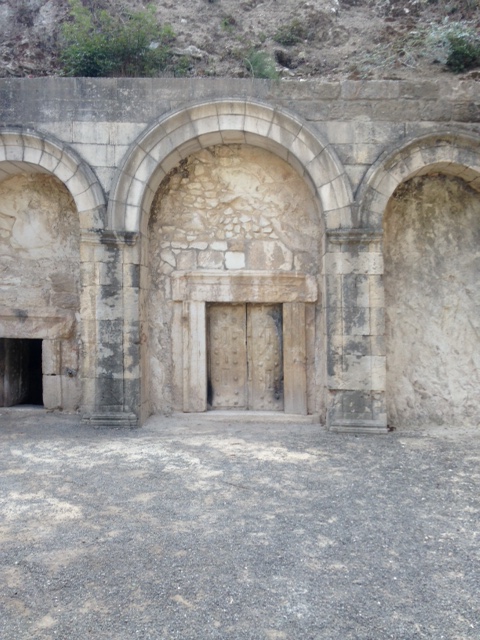Oral Law Tiyul:
Beit Sha'arim & Beit Alpha
by Gabriel Cohen, 11th grade, Massachusetts
 |
| An elaborate sarcophagus depicting a geometric design and an animal at Beit Shaa'rim |
For this trip we went to the location of the ancient town of Beit Sha’arim, one of the towns the Sanhedrin moved to. After Bar Kochva revolt was put down by the Romans, the southern portion of Eretz Yisrael was economically devastated, and, as we’ve been told before, if there is no prosperity, there can be no Torah study (Im Ein Kemach, Ein Torah). Beit Sha’arim, at the time, was the most prosperous place in Israel. It became such a center of wealth because it was the location where farmers would come to have their grain weighed and priced. This made it the perfect place for the Sanhedrin to continue their study and development of Oral Law.
 |
| one of my Kitat Nahal classmates is surprised to see a graven image on a sarcophagus! |
During this time, rabbis known as Tanaim were given long stretches of the Oral Law to memorize and pass down to the next generation. However, as the Romans started to make life more difficult for the Jews, the rabbis of the Sanhedrin were worried about losing the life a Tanaim and the oral law that he knew. As a solution, Rabbi Yehuda HaNasi, the leader of the Sanhedrin declared that the Oral Law was to be written down and codified in the Mishna. He had three reasons for his choice: 1) It would preserve the knowledge the law held, 2) The law could not be manipulated to any degree, and 3) There would be another thing that makes us Jewish. This idea clearly worked out since we still use the Mishna and the Talmud today.
 |
| entrance to the 2nd century burial caves of the rabbis of the Sanhedrin at Beit Sha'arim |
While we were learning all of this, we got to walk inside the burial caves of the members of the Sanhedrin and their families. There, we got to see some of the decorations on the sarcophagi of these rich families. We also found something quite disturbing: animals depicted on the sides of the tombs. It’s a little questionable on whether or not this is Avodah Zarah, but I'll let it slide. Then, we see the Greek goddess of victory, Nike. That’s definitely worship of false gods, right. Oh, but it gets worse! Next, we go to a synagogue at Beit Alpha with an entire mosaic floor with human images and the Greek sun god, Helios, right in the middle. How could anyone allow this to happen? What would the rabbis say?
 |
| Is this avoda zara (idolatry)? The zodia wheel and the sun god Helios appear in this synagogue? |
Well, actually there’s a story in the Talmud that actually justifies this. Rabban Gamaliel is in the bath house, a place where one would not normally see a Jew. Proclos, son of a plosphos, clearly thinking the same thing, asked him why he was in the bath house of Aphrodite. Rabban Gamliel's response was that since the goddess was not used as an idol, it was okay for him to be in there. This is actually similar to one of the dilemmas that we as Jews have today of dealing with Christmas culture. As long as it’s not religious, it’s okay.
In
conclusion, this tiyul was a fascinating look on the origins of one of our most
important law texts in our belief system. It also shows how the rabbis
justified some of the more questionable choices made by Jews during this time
period. All in all, another amazing trip.
 |
| Heller High students discover a giant menorah carved into the cave wall at Beit Sha'arim |
No comments:
Post a Comment